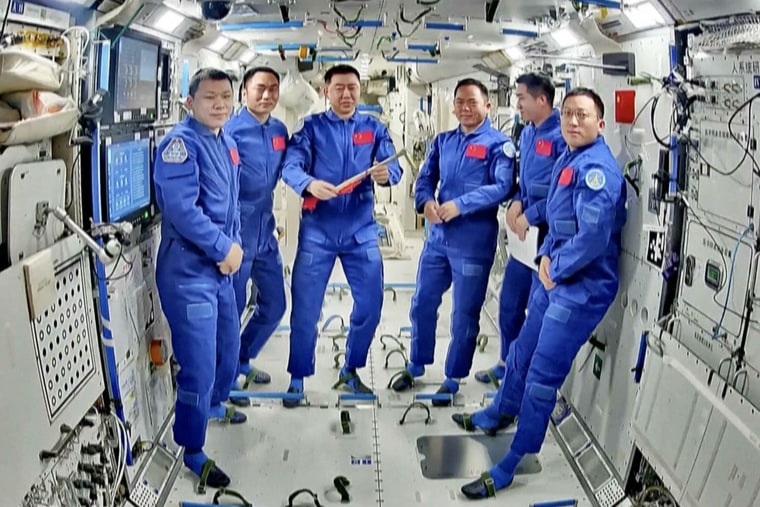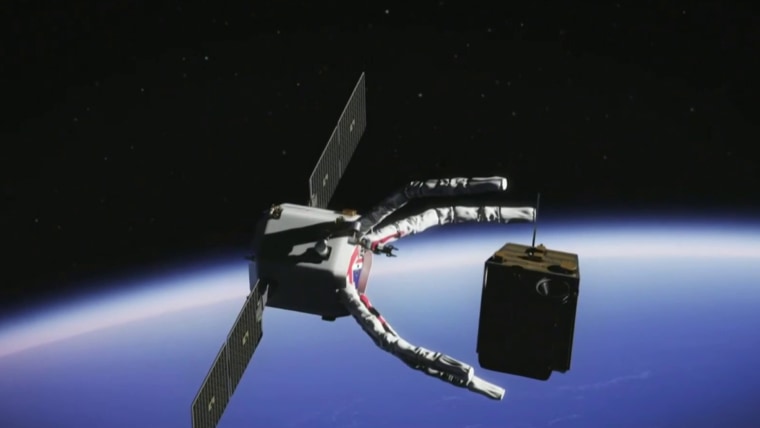BEIJING — China’s Shenzhou-20 crewed spacecraft has delayed its return mission to Earth after the vessel was possibly hit by tiny bits of space debris, the country’s human spaceflight agency said Wednesday, an unusual situation that could disrupt the operation of the country’s space station Tiangong.
An impact analysis and risk assessment are underway, the China Manned Space Agency (CMSA) said in a brief statement, without providing any new schedule for the return mission, which was originally set to land in northern China on Wednesday.
The delay highlights the danger to space travel posed by increasing amounts of space debris. The debris, also called space junk, consists of discarded launch vehicles or parts of a vessel that float around in space hundreds of miles above the Earth, risking collisions with countries’ active assets.
The Shenzhou program takes trios of Chinese astronauts to and from Tiangong for six-month stays where they perform a variety of tasks, including repairing damage to the station caused by debris impact.

The Shenzhou-19 crew’s return mission in April was delayed by one day due to weather conditions at the landing site. But this is the first time that a return mission has been delayed by space debris.
The CMSA did not say whether Shenzhou-20 was hit by debris mid-flight or while it was still aboard Tiangong, where the Shenzhou-21 is also currently docked after arriving last week. The crews of both vessels are currently in a handover period of several days. The statement did not mention Tiangong or Shenzhou-21.
According to well-established protocols, if the damage to Shenzhou-20 cannot be repaired aboard Tiangong, Shenzhou-21 will be used to transport the previous crew back to Earth.
In the event both vessels are damaged beyond repair, a backup Shenzhou spacecraft would be sent from the Jiuquan Satellite Launch Center in northwest China.
A backup Long March-2F rocket and Shenzhou spacecraft are always on standby at the launch center in the event of an in-orbit emergency.

While the delay could be short, there are cases of astronauts getting stuck in space after unexpected issues arise. Last year, technical issues affecting a Boeing Starliner spacecraft forced two NASA astronauts it brought to the International Space Station to stay there for nine months as they waited for an alternative vessel to bring them home.
The rapid increase in space junk in recent years has led to growing calls for cooperation on managing space traffic.
At a forum last year, Chinese President Xi Jinping called on Chinese and Arab countries to jointly build a “space debris observation center.”
A United Nations panel on space traffic coordination said last year that urgent action was necessary, calling for a shared database of orbital objects as well as an international framework to track and manage them.
China in 2021 complained to the U.N. that Tiangong had to perform two emergency avoidance maneuvers to avoid fragments produced by Starlink satellites, owned by Elon Musk’s SpaceX, which predominate in the Earth’s lower orbital paths.
Beijing and Washington have for years traded accusations of debris-creating behavior.
“A certain superpower, being the first country to conduct anti-satellite weapon tests in outer space, has carried out more such tests and created more space debris than any other country,” China’s permanent mission to the U.N. wrote in a 2022 document, referring to the United States.
The U.S. called a Chinese anti-satellite missile test in 2007 “irresponsible” after it destroyed a satellite in polar orbit and created a massive debris field.
China has invested in technologies that could be used to reduce the risk of a space collision caused by debris.
This includes deorbiting “sails,” which once unfolded can cause the attached spacecraft to speed up its descent into the Earth’s atmosphere, causing it to burn up without leaving space debris.

